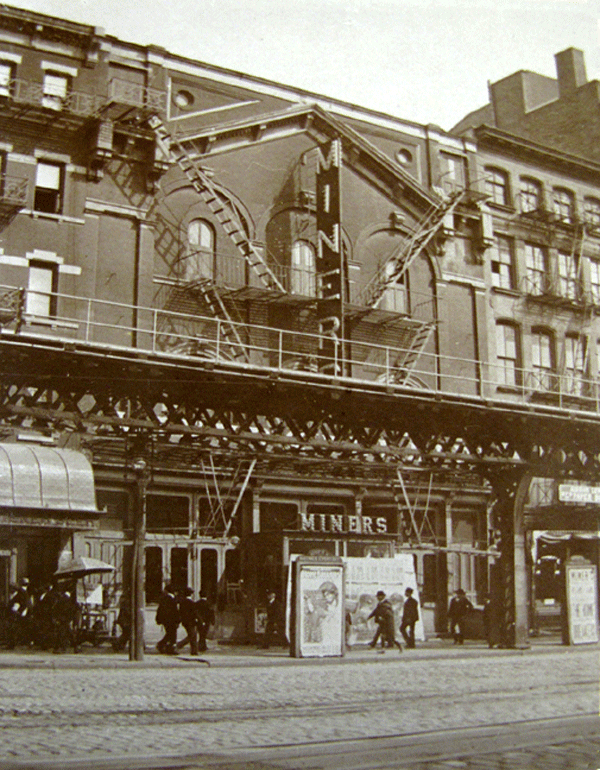BY TRAV S.D. travsd.wordpress.com | Sunday, March 23, marked the birthday of a once-important, now-forgotten New York theatrical impresario, politico and all-around mover and shaker named Henry Clay Miner (1842-1900).
Henry Clay Miner’s reach was longer than a shepherd’s crook
Miner began his adult life in the approved Bowery Boy fashion, as a city cop and volunteer fireman. He also obtained a degree in pharmacy from the College of Physicians and Surgeons and operated pharmacies, one of many revenue streams in what eventually became a multi-million dollar empire.

Miner’s Bowery Theatre, 165-167 Bowery.
In the 1860s, he began to amass experience that would serve him well in his theatrical activities. He was an advance man for Buffalo Bill, Wild Bill Hickok and Texas Jack. He booked a medical lecturer named Professor De Courcey, a magician and bird trainer named Signor Blitz and Slavianksi’s Russian Opera Company.
Miner’s first venture operating an actual venue was a short-lived dime museum and variety hall in Baltimore. He broke into New York by managing the clumsily named Falk’s Volk’s Garden in 1875. From there he went on to establish the London Theatre, an early vaudeville house located at 235 Bowery. He sold out to his partner James Donaldson in 1878. The London operated as a variety, burlesque and vaudeville emporium for another couple of decades, later becoming a Yiddish theatre, an Italian playhouse and a venue for Chinese opera. Today it is the site of the New Museum.
The success of the London allowed Miner to start what became New York’s first theatre chain, eventually encompassing the American Theatre, the 13th Street Theatre, Miner’s People’s Theatre, Miner’s 8th Avenue Theatre and the Fifth Avenue Theatre (which burned in a fire and was replaced with the Imperial Music Hall). He also owned theatres in Brooklyn and Newark.
But the most famous of all his houses was Miner’s Bowery Theatre (1878). Miner’s influential amateur night (instituted by Miner’s son Tom) played every other Friday. Performers were each given a dollar (which was a lot of money in those day), and winners were given fancy prizes, such as watches. The amateur night at Miner’s was popular; the audience, rowdy. A saloon and poolroom adjoined the theatre helped fuel the rambunctious energy, necessitating the use of hired “policemen” to roam the theatre ready to bust the heads of any troublemakers.
Somewhere along the line, someone got the bright idea of yanking particularly clueless acts offstage with a shepherd’s crook. This became known as “the hook” (as in “Give ‘im da hook!”). This device was widely emulated throughout the country, and has even become an idiom in the English language. The innovation lives on in popular memory, even if Miner’s Bowery Theatre does not.
Among the notable performers who trod the stage at Miner’s were Eddie Cantor, Weber and Fields, the Four Cohans, A.O. Duncan (vaudeville’s first ventriloquist), singer Lottie Gilson (known as “The Little Magnet”), monologist John W. Kelly “The Rolling Mill Man” and Charlie Ross (later of the team of Ross and Fenton).
In addition to his pharmaceutical and theatrical concerns, Miner also operated one of New York’s premier lithography printing companies, turning out beautiful color posters not only for his theatres, but for many others of the day.
These many enterprises made Miner a rich and powerful man. In time, he became cronies with Tammany Hall politician Big Tim Sullivan, and there was a certain amount of cross-fertilization between the two. Perhaps inspired by Miner, Sullivan went into the vaudeville business, becoming backer of the Sullivan and Considine chain, an important circuit in the Pacific Northwest. And Miner became a U.S. Congressman, representing New York’s Ninth district from 1895 to 1897. For someone named after Senator Henry Clay, this must have been a proud phase of Miner’s life. Nonetheless, Capitol Hill appears not to have suited him. He did not run for reelection, but returned to New York to run his business interests after one term. He passed away three years later, and now occupies a gorgeous mausoleum in Brooklyn’s Green-Wood Cemetery. His sons Edwin, Thomas, Clay and George continued to run his empire in the early years of the twentieth century.
Trav S.D. has been producing the American Vaudeville Theatre since 1995, and periodically trots it out in new incarnations. Stay in the loop at travsd.wordpress.com, and also catch up with him on Twitter, Facebook, YouTube, et al. His books include “No Applause, Just Throw Money: The Book That Made Vaudeville Famous” and “Chain of Fools: Silent Comedy and its Legacies from Nickelodeons to YouTube.”

















